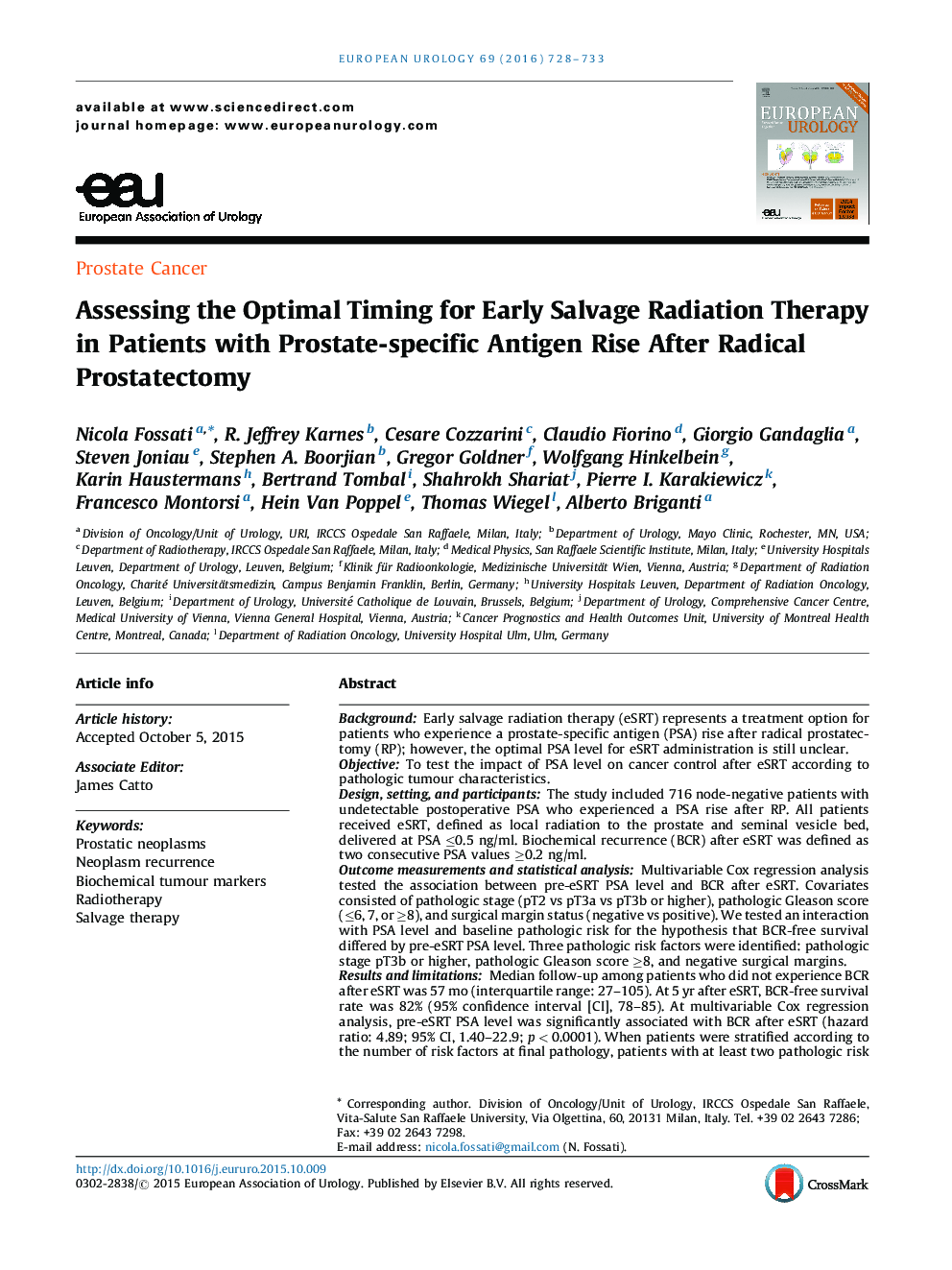| کد مقاله | کد نشریه | سال انتشار | مقاله انگلیسی | نسخه تمام متن |
|---|---|---|---|---|
| 6177560 | 1253103 | 2016 | 6 صفحه PDF | دانلود رایگان |
BackgroundEarly salvage radiation therapy (eSRT) represents a treatment option for patients who experience a prostate-specific antigen (PSA) rise after radical prostatectomy (RP); however, the optimal PSA level for eSRT administration is still unclear.ObjectiveTo test the impact of PSA level on cancer control after eSRT according to pathologic tumour characteristics.Design, setting, and participantsThe study included 716 node-negative patients with undetectable postoperative PSA who experienced a PSA rise after RP. All patients received eSRT, defined as local radiation to the prostate and seminal vesicle bed, delivered at PSA â¤0.5 ng/ml. Biochemical recurrence (BCR) after eSRT was defined as two consecutive PSA values â¥0.2 ng/ml.Outcome measurements and statistical analysisMultivariable Cox regression analysis tested the association between pre-eSRT PSA level and BCR after eSRT. Covariates consisted of pathologic stage (pT2 vs pT3a vs pT3b or higher), pathologic Gleason score (â¤6, 7, or â¥8), and surgical margin status (negative vs positive). We tested an interaction with PSA level and baseline pathologic risk for the hypothesis that BCR-free survival differed by pre-eSRT PSA level. Three pathologic risk factors were identified: pathologic stage pT3b or higher, pathologic Gleason score â¥8, and negative surgical margins.Results and limitationsMedian follow-up among patients who did not experience BCR after eSRT was 57 mo (interquartile range: 27-105). At 5 yr after eSRT, BCR-free survival rate was 82% (95% confidence interval [CI], 78-85). At multivariable Cox regression analysis, pre-eSRT PSA level was significantly associated with BCR after eSRT (hazard ratio: 4.89; 95% CI, 1.40-22.9; p < 0.0001). When patients were stratified according to the number of risk factors at final pathology, patients with at least two pathologic risk factors showed an increased risk of 5-yr BCR as high as 10% per 0.1 ng/ml of PSA level compared with only 1.5% in patients with one or no pathologic risk factors.ConclusionsIn this retrospective study, cancer control after eSRT greatly depended on pretreatment PSA. The absolute PSA level had a different prognostic value depending on the pathologic characteristics of the tumour. In patients with more adverse pathologic features, eSRT conferred better cancer control when administered at the very first sign of PSA rise. Conversely, the benefit of eSRT was less evident in men with favourable disease at RP.Patient summaryIn this retrospective study, cancer control after early salvage radiation therapy (eSRT) was influenced by pretreatment prostate-specific antigen (PSA) level. This effect was highest in men with at least two of the following pathologic features: pT3b/pT4 disease, pathologic Gleason score â¥8, and negative surgical margins. In these patients, eSRT conferred better cancer control when administered at the very first sign of PSA rise.
Journal: European Urology - Volume 69, Issue 4, April 2016, Pages 728-733
